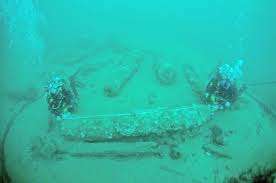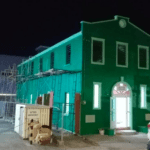
Artefacts rescued from a 17th century shipwreck are to go on display at an east of England museum next month, after being described as some of the most crucial maritime discoveries ever brought up from the depths.
HMS Gloucester sank off the coast of Norfolk in May 1682, after crashing at speed into treacherous sandbanks near to Great Yarmouth. Amongst those travelling on the ship that night was James, Duke of York, the brother of Charles II, and future King of England. Obviously he survived, but of the estimated 330 passengers on board, somewhere between 130 and 250 perished.
In June 2022 it was made public that the ship had actually been located 15 years earlier, half-buried in the seabed, around 28 miles (45km) out at sea. Divers had been carefully removing the precious finds from the stricken vessel, and these will now go on exhibition at the Norwich Castle Museum and Art Gallery on 25 February.
Experts declared the remarkable find as the most important since the Mary Rose was found in The Solent, the major English Channel shipping lane, back in 1971.
Huge haul of items causing great excitement
Amongst the many objects that will be seen by the public will be the ship’s navigational tools, many personal possessions belonging to the crew and passengers; plus the Gloucester’s bell. To enhance the exhibition, museums from all across Britain and Europe have kindly agreed to loan vital documents and paintings that are associated both politically and culturally, with the maritime history of the said period.
Visitors will also be able to gain an understanding of the ongoing research being carried out by the University of East Anglia (UEA) and get to see just how the wreck was discovered. Conservative councillor Margaret Dewsbury, the Norfolk County Council’s cabinet member for communities, said that the museum was “incredibly excited” to be able display the artefacts for the general public to “experience and enjoy”; adding that the county was the “home for the expertise required to research the remarkable heritage.”
Laboratory “honoured” to undertake restoration work
Before being put on display, items from the wreck were sent for some restoration work by experts at York Archaeology, which is one of only two laboratory’s in the country capable of handling such items of importance. In particular the unique artefacts from certain classes of people, especially the royal passengers.
Ian Panter, head of conservation, said he felt “honoured and privileged” to get the opportunity to work on the project due to the range of material and its historical significance. He remarked: “I started my career working on the Mary Rose and these are comparable, if not better.”
His colleague Scarlett Crowe, assistant conservator at the York laboratory, was equally thrilled to work on items from such as huge shipwreck. She explained some of the challenges facing the team, which included combatting humidity by the use of specific acid on iron that was on sets of combs, thought to be for wigs of the time. She too acknowledged how fortunate the team were to get up close to items of great historical value.
Mary Rose comparison
The Mary Rose shipwreck that Mr Panter referred to was of course the famous vessel which was King Henry VIII’s flagship, which sank in the Solent strait, north of the Isle of Wight, while leading an attack on a French invasion fleet in 1545. It was discovered some 426 years later in 1971 on the seabed and raised from its resting place in 1982.
In the region of 19,000 artefacts were found on board, in one of the most complex and expensive maritime salvage projects in history. The extensive collection of well-preserved recovered items proudly sit on permanent display at the purpose-built Mary Rose Museum in Portsmouth, which has attracted in excess of 100 million visitors since its creation.
Councillor pushing for tourist attraction
Little wonder then that a council leader in the town nearest to where the ship went down, was keen to push for a permanent home to be built in his borough. Carl Smith from Great Yarmouth Borough Council was also thinking even further ahead when he spoke of possibly even recovering the entire wreck, but after saying how fantastic that would be, he stated: “But even just having the artefacts on display, the history that brings to Great Yarmouth, would provide a marvellous tourist attraction for the resort.
Still more artefacts to come
Being slightly more realistic, Philip Miles, who is the exhibitions officer of the Time and Tide museum in Great Yarmouth, recognised that finding a permanent home for the items still some way off due to the long legal processes and vast amount of paperwork that are always involved. He explained: “Because it was a naval vessel, the Navy are still involved, and obviously the brothers are still involved too, ” adding that there are still more things on the seabed which are being recovered all the time.
15 year secret
The brothers to whom Mr Miles refers are Norfolk siblings and printers, Julian and Lincoln Barnwell, who together with their late father, their friend James Little, and one more associate who has preferred to remain unnamed, spent four years on diving expeditions to find the Gloucester’s watery grave.
Between them they made countless dives following their incredible discovery way back in 2007, but were able to keep their amazing feat away from public knowledge, until precious artefacts had been safely rescued from the seabed, in painstaking operations. They finally revealed their fantastic news 15 years after their initial exploits.
History could have been much different
Historians have spoken about how the disaster, in which many lost their lives, could have changed the course of history. They refer to the very real possibility that the then Duke of York, who would become King James II, could easily have been one of those poor souls to have drowned. He apparently fled the sinking ship with moments to spare and went on to become the Catholic heir to the Protestant throne, in an era marked by religious and political unrest.
Political turmoil and religious division
Late 17th century England was full of turmoil and division. There was a political campaign which was aimed at barring the Duke from the line of succession, due to his Roman Catholic faith. The reigning monarch, King Charles II was keen to shift royal power towards his brother James, who had been living happily with his then pregnant wife Mary of Modena, up in Scotland. The King wanted his younger brother back at the centre of government in readiness to succeed him.
At the head of the royal fleet
England were involved in wars with the Dutch around that time and James was Lord High Admiral of the Fleet, and had played an active role in the great sea battles of the period. He was aboard the flagship HMS Gloucester, which was a beautiful vessel, with ornately carved woodwork, accompanied by a fleet of warships, and the royal yacht Katharine that had amongst its passengers the naval administrator and diarist Samuel Pepys.
Heated arguments involving Duke of York
They were bound for Edinburgh, when they left Margate in Kent, early on 4 May, 1682, but the journey was plagued with difficulties from the outset. Murky weather on the first day of sailing forced the fleet to moor up for the night. As was the practice, the Gloucester seemingly fired a gun, signalling that the fleet should close and drop anchor. However, this message was misinterpreted by nearly half the fleet and they became detached.
By the second day of the voyage, the situation they found themselves in had rapidly worsened. With opinions divided, an angry confrontation ensued between the Duke, the ship’s captain James Ayres, together with numerous naval officers, principally about how best to navigate the potentially treacherous Norfolk sandbanks.
Fatal decision made
At the end of that second day a decision was made for the Gloucester not to moor up. Instead they decided to take advantage of the blustery winds blowing from a favourable direction and continued to sail at a speed of somewhere around six knots through the darkness, which was acknowledged as a fast speed for large sailing ships at night-time.
Almost inevitably, there was a violent collision, which broke the rudder, killing one man instantly. Water quickly began to fill the ship and the first duty was to ensure that the heir to the throne was first off, as only after James was safely away could attention be given to getting the other passengers and the crew into rescue boats.
Abandon ship
It is said that initially James was reluctant to abandon ship and even after eventually accepting the need to leave, he still prolonged his departure by attempting to rescue his strongbox, which it is believed contained his memoirs and political documents. These actions may well have cost lives, holding up other vital activities.
James Ayres was later imprisoned, and conspiracy theories have long suggested that the wrecking was even part of a republican plot to murder the future King.
Exhibition should be great success
The panic and terrifying events of the sinking and ultimate wrecking of the ship is captured in a very famous painting titled: “The wreck of the Gloucester off Yarmouth 6 May 1682” attributed to the Dutch artist Johan Danckerts.
The remarkable account of the circumstances leading up to disaster, and the astonishing findings by the Barnwell diving team, should ensure the exhibition is well attended and hugely successful.





0 Comments